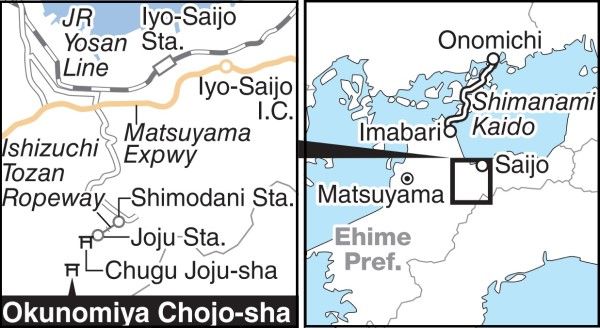
The Okunomiya Chojo-sha shrine sits on the summit of Mt. Misen in Saijo, Ehime Prefecture.
11:04 JST, August 1, 2021
SAIJO, Ehime — One myth states the deity Ishizuchihiko no Mikoto — the son of Izanagi no Mikoto and Izanami no Mikoto, who created Japan — descended from heaven to the rocky terrain of Mt. Misen, one of the peaks of Mt. Ishizuchi in Shikoku.
Mt. Ishizuchi is the highest mountain in western Japan. It is actually the collective name for several peaks, including Mt. Tengu, Mt. Nansempo and Mt. Misen. Mt. Tengu is the tallest of them, at 1,982 meters above sea level.
The mountain is revered as holy and worshipped as one of the Seven Holy Mountains of Japan, along with Mt. Fuji and Mt. Omine in Nara Prefecture.
Many famous figures in Japanese history have praised the mountain. Locals also love it as a guardian that blocks the wind and rain. They often personify the mountain, saying, “Ishizuchi-san will protect us,” when there are threats of typhoons and other natural disasters.
The Ishizuchi Shrine is said to have been established in 685 by En no Ozunu, or En no Gyoja, the founder of Shugendo, which is a fusion of mountain worship and Buddhism. The shrine is dedicated to Ishizuchihiko no Mikoto.
The entire shrine comprises four shrines: the Kuchi-no-miya Honsha main shrine at the foot of the mountain, the Chugu Joju-sha shrine around 70% of the way to the summit, the Okunomiya Chojo-sha shrine at the top of Mt. Misen and the Tsuchigoya Yohaiden.
One day, En no Ozunu tried to reach the summit, but just as he was about to give up due to its steepness and begin his descent, he met an old man who was sharpening an axe. He learned the man would continue sharpening the axe until it became as thin as a needle. Ozunu thus changed his mind and returned to his ascetic practices.
That’s what the legend says, anyway.

The statue of En no Ozunu stands at Mikaeri Yohaiden.
Joju-sha means “fulfillment shrine” in Japanese. The name comes from a legend in which Ozunu said, “My wish has been fulfilled,” when descending the mountain.
The Mikaeri Yohaiden in the fulfillment shrine was also named after an episode when Ozunu looked back toward the summit here. Mikaeri means “looking back” and yohaiden is a building for praying from a distance.
I also climbed Mt. Ishizuchi for the first time. I took a ropeway up the steep mountainside to an altitude of about 1,300 meters, passed through the grounds of the Joju-sha shrine, and went through the shrine gate. After praying for safety at the statue of Ozunu at the Mikaeri Yohaiden, I set off on the 7-kilometer roundtrip trail.
The mountain path ascended and descended again and again as I slowly went upward. As it was once a place for ascetic practices, the steep ascending stairs quickly made me gasp for breath. Still, I gritted my teeth and kept walking. Soon I could hear birds chirping and trees swaying in the wind. I felt as if my mind regained a sense of tranquility.

A slope with chains is seen on Mt. Ishizuchi, where worshippers use them to climb.
There are four places on the trail where you have to climb up the cliffs using chains. A detour route is available to avoid the chains, but even if you choose that route, there are still steep slopes and cliffs.
It took me about three and a half hours to reach the Chojo-sha (summit shrine). Looking down at the greenery from the top of the mountain and taking a deep breath, I felt like my tired body was filled with strength again. Was this the power of nature beyond human comprehension? For a few moments, I was intoxicated by my first taste of this feeling.
Three deity statues are enshrined in the main hall of the summit shrine, and visitors can directly touch them and state their wishes during rituals held every morning. Those staying at the Chojo-Sanso Lodge can participate in this ritual after watching the sunrise. The lodge also has a rest area, a store and a cafeteria.
“After a desperate battle with the steep path, worshippers reach a state of selflessness and become the person they are,” said priest Hideshi Sogabe, who has worked at the summit shrine every other year for nearly 20 years. “Surrounded by the invisible power of nature, one can feel awe and gratitude toward nature and deities,” he said.
How to get there
The Ishizuchi Tozan Ropeway is available at Shimodani Station, which is an hour’s drive from the Iyo-Saijo Interchange on the Matsuyama Expressway. To get to the Chugu Joju-sha shrine, take the ropeway for 8 minutes to the Joju Station and walk for 20 minutes. The Chojo-Sanso Lodge is open from the beginning of May to the beginning of November. The rate is ¥9,000 per night with two meals and ¥5,000 for elementary school students. Reservations are required. Guests can participate in the Shinto ritual from 6:00 a.m. for free.

A map of the Okunomiya Chojo-sha
Related Tags
"Features" POPULAR ARTICLE
-

Sanrio to Open Museum in Yamanashi Pref. Dedicated to Founder, Exhibits Include Hello Kitty, Other Characters
-

Autumn Foliage Surrounds Visitors to Tokyo’s Showa Kinen Park
-

My Daughter No Longer Speaks to Me, But I Want to See Her and My Grandchild
-

Kumamoto: Public Bath Refurbished as Library Where You Can Chat, Take Photos
-

Frozen Vegetables: Demand Rises for Convenient, Tasty Domestic Produce
JN ACCESS RANKING
-

Keidanren Chairman Yoshinobu Tsutsui Visits Kashiwazaki-Kariwa Nuclear Power Plant; Inspects New Emergency Safety System
-

Imports of Rare Earths from China Facing Delays, May Be Caused by Deterioration of Japan-China Relations
-

Tokyo Economic Security Forum to Hold Inaugural Meeting Amid Tense Global Environment
-

University of Tokyo Professor Discusses Japanese Economic Security in Interview Ahead of Forum
-

Japan Pulls out of Vietnam Nuclear Project, Complicating Hanoi’s Power Plans



























